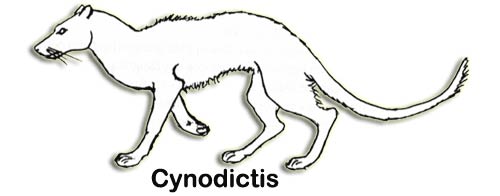Cynodictis, the ‘Dawn Dog’
January 28, 2008
Cynodictis, or “in-betwen dog” is the name given to a number of dog-like animals known from the late Eocene and early Oligocene of Europe (France and Germany), the late Eocene of Mongolia, and the Oligocene of North America (about 20~40 million years ago). The type species of Cynodictis, C. lacustris, is a member of the Amphicyonidae, but several fossil species that originally made up the genus have since been distributed among the genera Cormocyon, Cynarctoides, Phlaocyon, and Rhizocyon, all of which belong to the subfamily Borophaginae of the family Canidae.
Cynodictis are carnivorans that descended from Miacids, and are of the type that could be considered related descendants of a lineage that were ancestral progenitors of modern dogs, but their exact phylogenetic relationship is still not clear. Cynodictis may have given rise to two other species branches, one in Africa and the other in Eurasia. The Eurasian branch has been called Tomarctus.
Cynodictis had a long muzzle and a low-slung body. It had carnassial scissor teeth for slicing chunks of meat off carcasses. It lived on the grassy plains of North America, but researchers think it may have climbed trees in search of prey. It was about 30 cm in length – a small, carnivorous, dog-like mammal that could run very fast and dig efficiently. It used its speed to chase down rabbits and small rodents, but may also have been able to dig them out of their burrows. Cynodictis lived on open, emi-arid plains that were crisscrossed by rivers.
Using its digging skills, Cynodictis would make itself dens in steep riverbanks, which it would line with mouted fur and vegetation. In here the female Cynodictis would give birth to a litter of around five pups, which she would feed and protect for several months, suckling them at first, then later bringing them food. Unfortunately, the dens would sometimes be destroyed by flash floods that killed all the animals inside, but preserved them as fossils.
–from Wikipedia, Cynodictis

